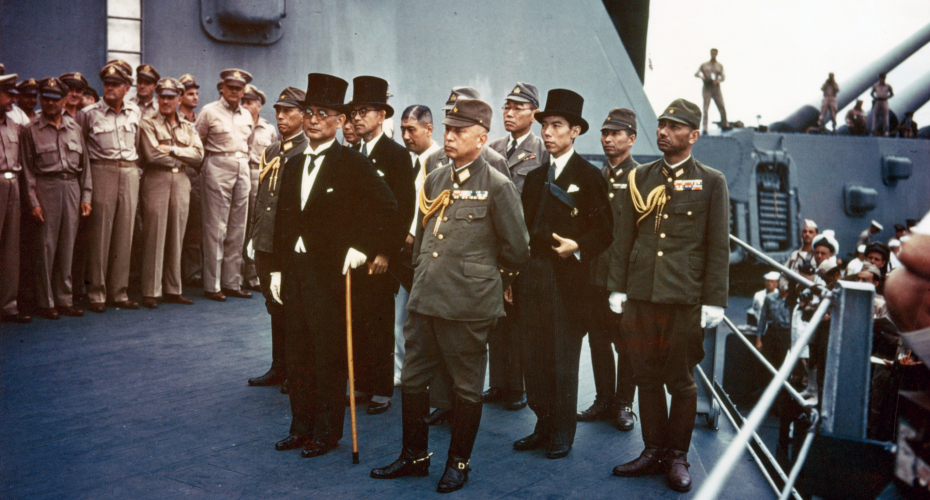Opinion: Unconditional Surrender 1945 – an 80th anniversary reflection upon VE and VJ Days

F Company Scots Guards march up Whitehall during VE Day Celebrations 2015. Credit Adrian Snood, via Wikimedia Commons
by Professor Richard Overy
It is now 80 years since Germany and Japan surrendered to the Allied powers on the basis of ‘unconditional surrender’, a demand laid down by President Franklin D. Roosevelt at the Casablanca Conference in January 1943. Although the requirement seems clear enough – to surrender without conditions – the demand raised difficulties when it came to ending the conflict. Even the officials in the U.S. State Department, who had to explain what precisely the term meant, were uncertain, and some at least argued that it was liable to provoke fanatical resistance from the enemy rather than make capitulation a straightforward matter.
When the Italian government after the overthrow of Mussolini, sued for an armistice in September 1943 the Western Allies agreed to allow the government and monarchy to remain and soon accepted that Italy was now on the Allied side. This suggested that there was some flexibility in the concept. Unconditional surrender did not necessarily mean quite the harsh result that it implied.
Nevertheless, the shared Allied ambition in 1945 was to ensure that both Germany and Japan did surrender unconditionally to all three major allies rather than try to negotiate a separate deal with any one of them. Indeed, it is possible now to argue that unconditional surrender was more important for the Allies as it committed them to fight to the bitter end rather than find a compromise. Stalin was distrustful of British and American aims and regularly feared that the two allies might reach an agreement with Germany or Japan that excluded the Russians. Neither Churchill nor Roosevelt (or their successors in 1945, President Harry Truman and prime minister Clement Attlee) wanted to alienate Stalin at this stage of the war. They remained solidly in favour of the maximum aim of complete surrender.
The real issue lay on the enemy side. Hitler would not brook the idea of surrender at any time and imposed this attitude on his commanders. He was obsessed with the idea of not repeating the armistice of 1918 which, in his view, had almost destroyed Germany and left a legacy of deep shame. As the Allies approached and then entered German territory, the army and security forces imposed a harsh terror against anyone who dared to express defeatist views or who shirked their duty to defend the fatherland. German soldiers fought with determination on the eastern front from fear of what a vengeful Red Army would do. Only the death of Hitler would make surrender possible.
By the time he committed suicide on 30 April 1945, most of the area of the ‘Greater German Reich’ was occupied by Allied forces. News of his death led to a rapid collapse of the war effort: German forces surrendered in Italy formally on 2 May; in northern Germany, Denmark, and the Netherlands on 4 May; in southern Germany on 5 May. Resistance was both hopeless and senseless and the German population waited with impatience for an end to the war.
On 5 May Hitler’s nominated successor as German president, Grand Admiral Karl Dӧnitz, sent an emissary to the Western Allied supreme commander, General Eisenhower to see if it was possible to surrender only in the west, and to continue fighting the Soviet army. It was made clear that this not possible. A second delegate, General Alfred Jodl, arrived the following day to be told the same. Eisenhower said that bombing would resume if surrender was not accepted, and in the early hours of 7 May, Jodl signed the instrument of unconditional surrender to all three major Allies.
This was not the end of the story. Stalin was furious that the surrender had not been made directly to the Red Army and insisted on a second surrender ceremony in Berlin on the 8 May. Here the chief of Hitler’s supreme command, Field Marshal Keitel, signed late at night, with General Georgii Zhukov signing for the Soviet side. As a result, VE day has had a different date for the Allies, 8 May for the British Commonwealth and the United States, 9 May for the Soviet Union (and still for Russia today).

Japanese surrender was also made difficult by the absence of any concept of surrender for the Japanese armed forces and for the emperor and his entourage. As the United States forces captured the islands close to Japan – Iwo Jima and Okinawa – the Japanese army and navy prepared for a last-ditch apocalyptic battle for the home islands, a collective national suicide. But unlike Germany, where surrender could not be discussed without accusation of betrayal, the Emperor Hirohito and his civilian advisers began to search for a way of ‘terminating the war’ (the expression used to avoid having to say ‘surrender’ or ‘capitulation’) from the spring of 1945.
The peace faction was anxious lest continued resistance provoke an internal collapse, like the Russian revolutionary crisis in 1917, and the Japanese elite dreaded the prospect of communism. By June, Hirohito pressed his government to find a means of ending the war; according to the constitution, he could not take the initiative himself, although he could make a ‘sacred decision’ if asked in a dire emergency. The government decided to ask the Soviet Union, which was not yet at war with Japan, to act as an intermediary with the United States. Stalin had already promised to enter the war against Japan once Germany was defeated, so the Japanese gambit was doomed. While the government in Tokyo waited for a response from Moscow, the Allies sent a final ultimatum to Japan in late July 1945 – the Potsdam Declaration – calling for unconditional surrender. Despite fears that this would mean the end of the divine imperial order, Hirohito thought the conditions acceptable. The government and armed forces waited for the reply from Moscow.
It was at this point that the atomic bomb was dropped on Hiroshima. Once it was clear that the bomb would work, following a test in mid-July, the American War Department authorised the strategic air force commander in the Pacific, General Carl Spaatz, to drop two bombs when the weather permitted at some point after 3 August. The first bomb was dropped on Hiroshima in the early morning of 6 August, the second on Nagasaki three days later. There was no certainty that the bomb would provoke surrender, though President Truman hoped it would, and so the United States navy and army continued planning for the invasion of the home islands in November, while more bombs were in preparation to wage a nuclear war in the last months of 1945. The Emperor did make a ‘sacred decision’ in the early hours of 10 August to accept the Potsdam ultimatum, and the view has remained ever since that the bomb must explain this decision.
In reality, the bomb had much less effect than the popular history suggests. It took days before investigation by the army and Japanese scientists could confirm whether or not it was an atomic bomb, and the argument went on even after the decision to terminate the war. The view among the leadership saw the bomb as an extension of the five months of city bombing, which had already burned down 60 per cent of the urban area. This campaign created widespread social problems and helped to provoke the fear of social upheaval among the peace faction. Political anxiety played a major part in Hirohito’s efforts to terminate the war. The atomic bomb simply provided an additional motive, but was not the principal one.
The real turning point came on the evening of 8 August. The Japanese ambassador in Moscow arrived finally to get an answer from the Soviet foreign minister, Vyacheslav Molotov, to be told instead that the Soviet Union was declaring war on Japan. The following day, the Red Army smashed its way into the Japanese empire in Manchuria in northern China and threatened to arrive in Japan proper before the Americans.
The discussions all day on 9 August still saw the army wanting conditions for accepting the Potsdam Declaration, so eventually the deadlock was presented to the emperor for a unique ‘sacred decision’ late in the evening. Hirohito said that the ultimatum had to be accepted to avoid the destruction of Japan, and in the early hours of 10 August, Washington was notified. The menace of a communist invasion was a major incentive. Tokyo knew what the Soviet invaders had done in Eastern Europe.
This was not the end of the drama. Acceptance on 10 August had also carried the rider that the imperial system should continue. The American side argued about what this would mean and insisted that Hirohito would be subject to the Allied supreme commander, General Douglas MacArthur. After three more days of argument in Tokyo between the peace faction and the armed forces, Hirohito announced a second ‘sacred decision’ on the morning of 14 August, insisting that there should be no more disagreement and that the ultimatum had to be accepted. Neither he nor any of his advisers called it a surrender, but termination of the war to the benefit of all, a linguistic sleight of hand to avoid admitting complete defeat. The emperor recorded his imperial rescript on termination for broadcast to his people on 15 August. A group of younger officers tried to storm the palace, destroy the recording and assassinate the members of the peace faction. They failed, and on the morning of 15 August, the emperor’s words were heard across Japan for the first time. The imperial decision has never been called unconditional surrender either then or now, but that was how the Allies treated it. A formal surrender ceremony only took place more than two weeks later, on board the US battleship Missouri, in Tokyo Bay. Under MacArthur’s protection, Hirohito kept his throne.

Both surrenders were messy affairs rather than a straightforward capitulation, and the determination to fight on in both cases cost untold thousands of additional deaths and further physical destruction. Unconditional surrender has not been used since then as a stated war aim, nor was it an aim expressed during the war by the Axis powers, which might have preferred some kind of compromise. It did mean that the war would be fought to the bitter end, so determined were the Allies to stamp out the imperial and territorial ambitions of their enemies.
Professor Overy’s latest book, Rain of Ruin: Tokyo, Hiroshima, and the Surrender of Japan, was published by Allen Lane in March.



